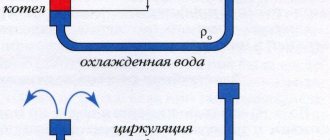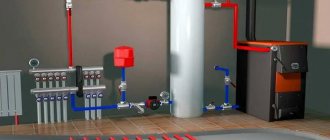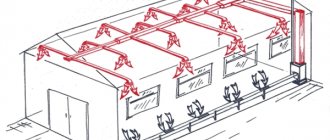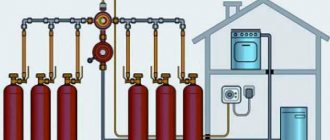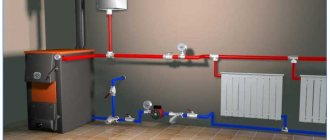Heating is one of the privileges that people need for a comfortable life. To avoid connecting each apartment to separate heating, an entire system is installed in the house. Such systems vary depending on the type of house, its size and the number of apartments.
In the paragraphs of this article we will try to answer in detail questions regarding the heating system of a house.
How does the process of heating a high-rise building take place?
Each apartment building has a central heating system, which consists of the following elements:
Boiler houses and thermal power plants act as sources of thermal energy.
From boiler rooms to houses, hot water is sent immediately and requires a decrease in temperature, otherwise the heating equipment of the house will be damaged. In a thermal power plant, it is converted into steam to produce electricity, then this steam is used to heat the coolant entering the heating network of the building.
What is a “heating network” and a “heating unit”
The home heating network is a set of pipelines that provide heat to each living space. This is a complex system that consists of two heat pipes: hot and cooled.
Thermal unit – heating equipment system; the place where the hot water pipe merges with the heating system of the building. This is where heat distribution and metering takes place.
The list of tasks performed includes:
- monitoring the condition of the heat source;
- monitoring the condition of water and heat pipelines;
- registration of data from metering devices.
Types of heating units
In multi-storey buildings, two types of heating units are used.
Single-circuit provides a direct connection to hot water supply pipes, that is, the heat pipes are connected using an elevator. In high-rise buildings, the heating network is quite extensive, but most of the equipment is located in the basement.
Important! The diagram of a double-circuit heating unit is a system of two heat pipes in contact with each other through a heat exchanger.
Next, we will consider in more detail the principle of operation of a single-circuit thermal unit. Due to its design, namely the presence of an elevator, and low cost, it is used most often. For companies that install heating equipment and heating units, it is more profitable to use elevator units that are outdated and do not require careful attention.
Device
The single-circuit thermal unit is designed most simply. As already mentioned, it consists of a pipe extending from the heat source and a “cold” pipe, which are connected using an elevator. Also on the pipes there are filters and measuring instruments that monitor the flow, temperature of the coolant and pressure in the pipes.
Filtration equipment is installed, since the entire heating system reacts quite negatively to dirt and sediment in the coolant. Over time, it needs to be cleaned or replaced.
Important! If the pressure is unstable, a device is installed in the heating unit to reduce it.
Installing meters has some nuances:
- placed on a pipe with “reverse” heat;
- it must be located as close as possible, as realistically as possible, to the heat source;
- setting parameters (required amount of heat per hour, day).
Operating principle
In this paragraph we will tell you what processes occur inside the elevator heating unit.
According to the scheme, hot water supplied by utilities enters the house through a “hot” pipe. Having “bypassed” the entire building, it returns to the node in a cooled state and is removed from the system. But in the elevator, hot and “cold” water are mixed, preventing the temperature from going beyond acceptable limits. There are situations (suitable for areas with low temperatures) where a heating mechanism is built into the elevator: if the temperature of the water during mixing is below the permissible level, the mechanism is turned on.
The in-house heating system can be disconnected from the city heating system using valves. Such actions are carried out during repair work and for general prevention. For such cases, there are special valves on the pipes designed to remove water from the system.
Important! All parts of the unit are connected to the heating system using flange connections.
The use of a single-circuit unit has both advantages and disadvantages.
The advantages of such a heating unit are:
- ease of use;
- rare breakdowns;
- relative cheapness of components and their installation;
- completely mechanized and does not depend on external energy sources.
The main negative aspects:
- for each heat pipeline, personal calculations of parameters are required to select an elevator;
- the pressure in each pipe should be different;
- manual adjustment only;
- Who installs and maintains the heating unit.
In houses with a large number of apartments there is a heat and hot water supply system from the city, which is located in the basement. Such a heating system requires preventive maintenance. The “weakest link” is the filters, or mud collectors, which need to be monitored and cleaned (all the dirt from the coolant accumulates in them).
This work is done, or at least should be done, by mechanics from the housing and communal services authorities who service the building. Since the heating center is complex and dangerous to operate, intervention by strangers is under no circumstances allowed, and diagnostics and repairs are allowed only to specially trained personnel.
Individual heating in residential buildings
In addition to central heating, you can find autonomous heating of an apartment in an apartment building; usually such a heat supply is rare and has been installed in new buildings in recent years. Local heat supply systems are also used in the private residential sector. For individual heating in an apartment building, the boiler room is usually located either in the building itself in a separate room or close to the house, since it is necessary to regulate the temperature of the coolant in the heating system.
The cost of autonomous heating in an apartment building is quite high, so it is preferable to commission one powerful boiler house that can provide heat and hot water to a residential neighborhood.
Possible problems
The heating system of a house is a complex mechanism. Some breakdowns and malfunctions are inevitable. But most often problems arise in the heating unit, namely, elevator failures. Reasons of a mechanical nature: defects in shut-off equipment, clogged filters. Because of this, a temperature difference occurs in the pipes before and after passing through the elevator. If the difference is not big, then the problem is not serious: you just need to clean the elevator. Otherwise, repairs are necessary.
Other problems with the heating unit include an increase in the permissible temperature of the measuring equipment and the occurrence of leaks in pipes. When the filters in the pipes become clogged, the pressure increases.
Important! In case of any problem, it is necessary to diagnose the entire heating system.
As already mentioned in the article, elevator units are an obsolete technology. Gradually, in apartment buildings they are being replaced by automatic heating units, which do not require constant human control and regulate all indicators themselves.
The disadvantage of such heating systems is their high cost and, like any automated device, it runs on electricity.
However, devices are built into the circuit of single-circuit units that make it possible to regulate the temperature and pressure in the incoming coolant. Thus, it allows people to save money when paying for utilities.
What is a thermal unit and how does it work?
Greetings to everyone who reads my blog! Today I want to offer you another article that is dedicated to heating. In this article I will tell you about a strange place in the basement of your house called a heating point (or heating unit). The article aims to give you a general idea of what a thermal unit is, how it works and why it is needed. Let's begin to understand these issues with the most fundamental of them.
Heating system of an apartment building. Educational program with examples
Hi all! My name is Victor and this is my first post on Giktimes, please do not judge strictly. I myself am a web programmer in life, but among other things, I am also a member of the board of the HOA, and therefore I am actively involved in housing and communal services issues. Housing and communal services in Russia are stuck in the 80s of the last century, although housing and communal services technologies have moved forward a long time ago. If the community doesn’t mind, I will periodically share with you practical thoughts and information on the topic of housing and communal services, what and how can be done to, at least within the confines of my home, move the situation forward.
How does a central heating system work?
In most houses in our vast Motherland, which, by the way, consists of 2/3 permafrost, heat is supplied to apartments from thermal power plants, and this is proudly called “central heating.” This is what we will talk about today. The thermal power plant heats the coolant and through pipes, like blood vessels, through the entire city the heat comes to your house: first to the heating unit, which is usually located in the basement, and then to the radiators of your apartment. Giving up heat, the coolant cools down and through the so-called return flow goes back to the thermal power plant. By the way, as a rule, the coolant is ordinary water with the addition of additives that prevent deposits in heating radiators and pipes. By the way, there is a very important nuance here, which, as my practice has shown, even many plumbers are not aware of. The heating unit has an elevator unit, an invention of the 19th century, but, alas, still widely used.
In the elevator unit, there is a so-called nozzle, also known as a cone. Many plumbers believe that its task is simply to narrow the cross-section so that less heat enters the house. Not really. Its task is to create a vacuum at which hot water from the supply pipeline at high speed, but with lower pressure, begins to mix with the cooled return (with the water that has already passed through the heating radiators of your house) and due to this, the heating temperature is regulated at entering the house. Unfortunately, the nozzle is a primitive device, invented in the 19th century, and therefore the mixing always occurs the same, no matter what the temperature outside is +5 or -40.
Many plumbers, when they receive complaints from residents who feel cold, bore the elevator nozzle above the standard section or even remove it completely. It is strictly not recommended to do this, since according to the schedule, in severe frosts, the thermal power plant supplies coolant under extremely high pressure with temperatures up to 130 degrees! If you let such heat into an apartment, and God forbid the heating radiator breaks through, casualties are guaranteed. By the way, it is precisely for this reason that manufacturers of polypropylene pipes, so widely loved by Russian plumbers, prohibit or do not recommend using them for central heating
. Most polypropylene pipes hold a maximum of 90 degrees, and even then, for a relatively short period of time. Now look at the pipes in your apartment and think about it.
Thermal computer
Almost every home already has a special device called a thermal computer. Its task is to calculate how much heat your home has absorbed. Unfortunately, due to historical reasons, when we had everything in common, and therefore no one’s, we were not used to counting heating costs. Meanwhile, today heating is the most expensive expense item in bills. Moreover, due to the fact that historically no one considered heating in our country - this area is now the most bribe-intensive and extremely ineffective. And in order to somehow correct the situation, everyone who is interested in what kind of numbers they are given in utility bills must remember and understand the main formula in housing
: Namely, according to this school formula, the heat meter calculates the cost of heating for you: m is the mass of the coolant, which passed through your house in 1 hour, dT is the temperature difference between supply and return. Those. at the inlet, for example, 80 degrees, the coolant, after passing through the heating radiators of the house, cools down to 50 degrees - dT is equal to 30 degrees. By multiplying the mass of the coolant by the temperature difference, we get that same Gigacalorie. Each region sets its own price for 1 Gigacalorie, for example in my Vladimir it is 1987 rubles 40 kopecks. The Q received for the month is multiplied by the tariff, then divided by the total living area of the house, and we get the cost of heating per 1 square meter. Well, how many square meters you own, that’s how much you actually have to pay. Here is such a fairly simple scheme, which many in our country are not even aware of, including, to everyone’s surprise, even those who deal with this very housing and communal services (as my practice has shown).
Only by understanding how a heat meter works and what determines the price for heating can you address energy saving issues. And as the formula shows, you can save either on the temperature difference or on the mass of coolant passed through the house. Here we need to make a reservation, just like that, you cannot take the supply and return it, if the house does not take in any heat at all, and the difference in supply and return temperatures is less than 3 degrees, such a heat meter is removed from the register and the house is assigned payment according to the standard. This is a feature of the city’s heating network that we will not touch on now.
Let's go down to the basement
Well, now we come to the most interesting part. Most modern thermal computers are very modern devices, the capabilities of which are not used at all, due to the fact that the houses are managed by plumbers Vasya from the distant past and grandmothers from the HOA. I urge all IT specialists not to be lazy and go down to the basement of your house and look at this very interesting computing device.
For example, the Thermotronic TV7 heat meter ended up in my house:
This device has quite a lot of capabilities, such as connecting via Ethernet, USB, RS-232, but most importantly, it has an SD card reader. You just need to insert an SD card into it, and it will automatically record the entire history of readings - pressure, temperature, coolant volume and other characteristics necessary to calculate the cost of heating. By the way, in my case it also turned out that if native flow meters were used (a sensor that calculates the mass of the coolant), then it would be possible to automatically detect leaks in the house and send an SMS to the plumber - you have a flood, run to the house!
And so we downloaded the data from the heat meter, and now using the Archiver program we can process the data from the meter:
The program itself is quite primitive, and cannot even build graphs, and does not even export to Excel. But good old ctrl-c ctrl-v makes it easy to deal with the problem!
Drawing graphs
Now that we have the data in Excel, we can draw graphs and draw some conclusions. Oh, how much you can see in the graphs! For example, in the first graph there are two subsidences in the volume of coolant (upper dark blue and gray lines) passing through the house; this is most likely a pipe failure in the area. Just coincides with the increase in supply temperature (frost!)
The right axis is Q, showing heat in gigacalories per day. As I already said, at the rate of 1 Gigacalorie in Vladimir it costs 1987.40 rubles. On the graph, Gigacalories are marked with a yellow line. This is how many gigacalories the house will accumulate in a month, this amount is multiplied by 1987.40 rubles, then divided into apartments and you pay it in your utility bills.
The red and blue lines are the supply and return temperatures. Values on the left scale. The green line is the delta, i.e. that temperature, how much your house took to heat. As you can see, the supply temperature in cold weather is above 100 degrees. And if it breaks, it’s life-threatening!
You can notice that despite the fluctuating supply temperature, the return temperature is always approximately the same. This is an interesting phenomenon. Does anyone know why? I have a version, but for now I’ll keep it to myself, go in the comments! It’s a shame, really, that we can’t save on the obvious, on the temperature difference.
This is an interesting phenomenon. Does anyone know why? I have a version, but for now I’ll keep it to myself, go in the comments! It’s a shame, really, that we can’t save on the obvious, on the temperature difference.
The dark blue and gray lines are the volume of coolant passing per hour through the inlet and outlet, respectively. For some reason, we spend a little more than we receive. Either there is a measurement error, or something is leaking somewhere... I will look into this issue.
And the second figure is hourly consumption over the last 24 hours. Here, basically all the peaks in gigacalories (orange line) are associated with life at home. They get up at 7 am, lunch at 12, dinner at 5 pm, and around 9-10 pm everyone takes a shower and actively pours hot water. What disciplined neighbors I have! 
Well, now that it is possible to monitor the heat consumption of an apartment building, we can raise the issue of energy efficiency. First of all, I plan to wrap all the pipes in the house in energyflex, as well as install weather-sensitive automation, throw out the prehistoric elevator unit from the circuit, and install a modern three-way valve that can be controlled automatically or via the Internet. I carry out this whole matter with thermal imaging control. I think I will also publish several posts about the thermal imager if the audience accepts this topic. Well, in general, I plan to closely address the issue of energy saving, since at the moment the energy consumption readings at home are extremely high, which we can clearly see on the graph.
Why do you need a thermal unit?
The heating point is located at the entrance of the heating main to the house. Its main purpose is to change the parameters of the coolant. To put it more clearly, the heating unit reduces the temperature and pressure of the coolant before it enters your radiator or convector. This is necessary not only so that you do not get burned from touching the heating device, but also to extend the service life of all heating system equipment. This is especially important if the heating inside the house is installed using polypropylene or metal-plastic pipes. There are regulated operating modes of thermal units:
These figures show the maximum and minimum temperature of the coolant in the heating main.
Also, according to modern requirements, a heat meter must be installed at each heating unit. Now let's move on to the design of thermal units.
How is the thermal unit arranged?
In general, the technical structure of each heating point is designed separately depending on the specific requirements of the customer. There are several basic schemes for the design of heating points. Let's look at them one by one.
Thermal unit based on an elevator.
The scheme of a heating point based on an elevator unit is the simplest and cheapest. Its main drawback is the inability to regulate the temperature of the coolant in the pipes. This causes inconvenience for the end user and a large overconsumption of thermal energy in the event of thaws during the heating season. Let's look at the figure below and understand how this circuit works:
In addition to what is indicated above, the thermal unit may include a pressure reducer. It is installed on the feed in front of the elevator. The elevator is the main part of this scheme, in which the cooled coolant from the “return” is mixed with the hot coolant from the “supply”. The operating principle of the elevator is based on creating a vacuum at its output. As a result of this vacuum, the coolant pressure in the elevator is less than the coolant pressure in the “return” and mixing occurs.
Thermal unit based on a heat exchanger.
A heating point connected through a special heat exchanger allows you to separate the coolant from the heating main from the coolant inside the house. The separation of coolants allows for its preparation using special additives and filtration. With this scheme, there are ample opportunities to regulate the pressure and temperature of the coolant inside the house. This allows you to reduce heating costs. To have a clear idea of this design, look at the figure below.
The mixing of coolant in such systems is done using thermostatic valves. In such heating systems, in principle, aluminum radiators can be used, but they will last for a long time only if the coolant is of good quality. If the PH of the coolant goes beyond those approved by the manufacturer, then the service life of aluminum radiators may be greatly reduced. You cannot control the quality of the coolant, so it is better to play it safe and install bimetallic or cast iron radiators.
DHW can be connected in a similar way via a heat exchanger. This offers the same benefits in terms of hot water temperature and pressure control. It is worth saying that unscrupulous management companies can deceive consumers by lowering the hot water temperature by a couple of degrees. For the consumer, this is almost unnoticeable, but on a household scale it allows you to save tens of thousands of rubles per month.
Hot water supply in heating systems
DHW in multi-storey buildings is usually centralized, with water heated in boiler rooms. Hot water supply is connected from heating circuits, both single-pipe and double-pipe. The temperature in the hot water tap in the morning can be warm or cold, depending on the number of main pipes. If there is a single-pipe heating supply to an apartment building with a height of 5 floors, then when you open a hot tap, cold water will flow out of it first within half a minute. The reason lies in the fact that at night, rarely do any residents turn on the hot water tap, and the coolant in the pipes cools down. As a result, there is an overconsumption of unnecessary cooled water, since it is drained directly into the sewer.
Unlike a single-pipe system, in a two-pipe version, hot water circulates continuously, so the above-described problem with hot water does not arise there. True, in some houses, a riser with pipes is looped through the hot water supply system - heated towel rails, which are hot even in the summer heat. Many consumers are interested in the problem with hot water supply after the heating season has ended. Sometimes hot water disappears for a long time. The fact is that utility services are obliged to comply with the rules for heating apartment buildings, according to which it is necessary to carry out post-heating tests of heat supply systems (pro



